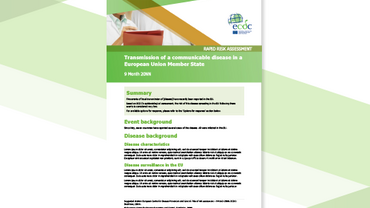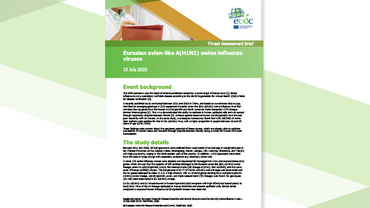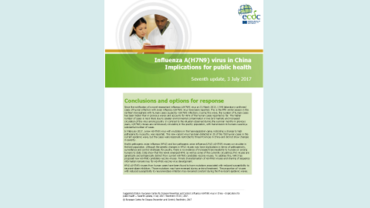Rapid Risk Assessment: Outbreak of highly pathogenic avian influenza A(H5N8) in Germany, 13 November 2014
This rapid risk assessment details an outbreak of highly pathogenic avian influenza virus A(H5N8) at a turkey holding in Germany reported by the German authorities on 6 November 2014. Those at risk are mainly people in direct contact with diseased turkeys or their carcasses – e.g. farmers, veterinarians and those labourers involved in culling. Local health authorities may consider actively monitoring poultry workers exposed at the affected holding.The public health threat is considered to be very low since to date, no human infections with this virus have ever been reported world-wide.
Executive Summary
On 6 November 2014, German authorities reported an outbreak of highly pathogenic avian influenza virus A(H5N8) at a turkey holding. Culling of the turkeys at the affected holding has started, protection and surveillance zones have been established, and investigations initiated to establish how the birds became infected.
This virus has been detected among wild birds in south-east Asia where it has also caused several outbreaks on commercial poultry farms in South Korea and China. However, this is the first time it has been detected in Europe. It remains unclear how this virus was introduced into a turkey flock at a German holding.
The public health threat from this event is considered very low. To date, no human infections with this virus have ever been reported world-wide and the risk for zoonotic transmission to the general public in the EU/EEA countries is considered to be extremely low. The ability of this highly pathogenic avian influenza virus to subclinically infect wild birds increases the risk of geographical spread and subsequent outbreaks, as observed in South Korea. The ongoing monitoring and testing of wild birds and domestic poultry in the EU therefore plays an important role in the possible detection of further virus occurrences.
In order to prevent virus spread the Directive 2005/94/EC requires that Member States have contingency plans detailing measures for the killing and safe disposal of infected poultry, feed and contaminated equipment as well as the procedures and methods for cleaning and disinfection. Persons at risk are mainly people in direct contact/handling diseased turkeys and other poultry, or their carcasses (e.g. farmers, veterinarians and those labourers involved in the culling.) It is further required that contingency plans for the control of avian influenza in poultry and birds be developed in collaboration with public health authorities to foresee that persons at risk are sufficiently protected from infection.
Poultry workers exposed at the affected holding should be monitored for ten days in order to document possible related symptoms. Local health authorities may consider actively monitoring these groups.







